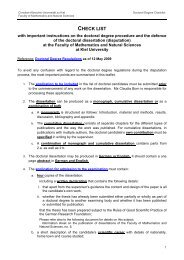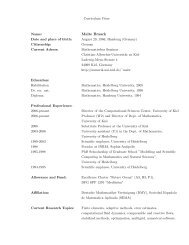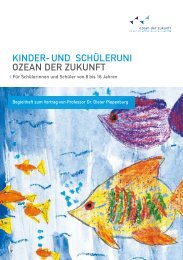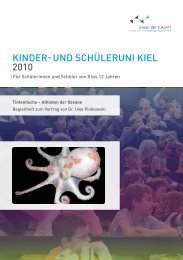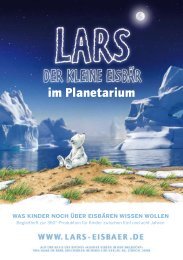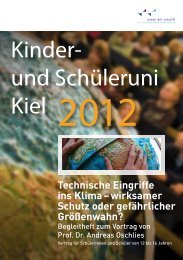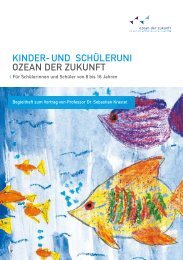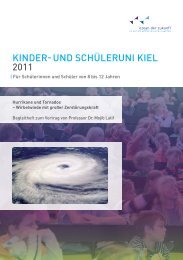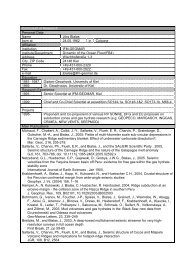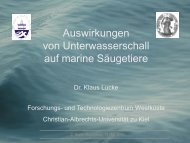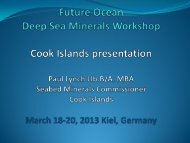available, it is unknown whether the marine biota will be able to adapt or evolve to the rapidchanges in ocean chemistry and whether, ultimately, the services that the ocean’s ecosystemsprovide will be affected. Previous ocean acidification events, such as during the Paleocene-Eocene<strong>The</strong>rmal Maximum (PETM, 55 Ma), may serve as suitable analogies to assess the adaptivepotential of the marine biota. Because ocean pH affects many biological, chemical, andsedimentological processes, its continuing decrease is expected to fundamentally change thebiogeochemical and ecological balance of the ocean.3. Previous and on-going work of the proponents<strong>The</strong> proponents have studied the impacts of CO 2 -induced seawater acidification on marineplankton at the species to ecosystem level (Riebesell et al. 2000, Engel et al. 2005). <strong>The</strong>y haveused electrophysiological techniques to characterize ion transport proteins involved in cellular pHhomeostasis and have measured intracellular Ca 2+ and pH by means of fluorescent dyes (Bleich etal. 1998). Biological indicators, such as nutritional condition indices for larval fish and cephalopodsand the microchemical composition of cephalopod and fish earstones, are being developed tocharacterize environmental life history traits and migration patterns (Melzner et al. 2004). <strong>The</strong>proponents have performed modeling studies of climate change effects on marine ecosystems(Wirtz & Wiltshire 2005) and continue to develop new models for the interaction of marinechemistry and biology on the cellular and ecosystem level with a strong emphasis on adaptationprocesses. In situ studies include biomineralisation processes of cold-water corals and atcarbonate seamounts (Schönfeld et al. 2005) as well as extensive surveys of calcareous plankton(Regenberg et al. 2006). <strong>The</strong> analysis of high-resolution stable isotope records in Nordic Seas isused to reconstruct changes in past environmental conditions over periods of high and lowatmospheric CO 2 levels. Major research initiatives of the proponents related to ocean acidificationinclude the EU projects PeECE, CARBOOCEAN and HERMES, the DFG projects CASIOPEIA,<strong>Ocean</strong> Gateways, DecLakes and LiIONS and the proposed BMBF Verbundprojekt SOPRAN.Project proponents have co-authored the Royal Society Report on <strong>Ocean</strong> Acidification, co-chairedthe SCOR/IOC conference “<strong>The</strong> <strong>Ocean</strong> in a High CO 2 World”, the IGBP-SCOR Fast Track Initiative“<strong>Ocean</strong> Acidification“ and have played leading roles in developing the SOLAS and IMBER scienceplans, which both promote research on ocean acidification.4. Objectives<strong>The</strong> objectives addressed by the new Junior Research Group (JRG’s) and the proponents will beto (1) achieve a mechanistic understanding of CO 2 /pH-sensitive processes at the molecular toorganism level, (2) examine synergistic effects of changes in temperature and oxygenconcentrations (hypoxia), and (3) assess the potential for biological adaptation to high CO 2 / low pHlevels. <strong>The</strong> JRG will act as a bridge between and expand existing expertise by an integratedapproach combining molecular, biochemical, and cell-physiological techniques with CO 2 /pHperturbation studies on a variety of scales (at the cellular to community level). JRG research willbenefit from and be integrated into laboratory-, mesocosm-, field- and model-based studies carried35
out by the proponents and will establish new techniques for the study of biomineralization, cellularion regulation and micro-evolutionary adaptations. Research may include the use of natural high-CO 2 environments, bioinformatics, stable isotope analysis, micro-sensor techniques, processorientedmodeling, and comparison with previous ocean acidification events, such as those whichtook place during the PETM and the Mid-Miocene Climate Optimum (14-17 Ma). <strong>The</strong> primary goalwill be to develop predictive capabilities for biological responses and possible adaptations to CO 2 -induced ocean acidification.Links to other topics in the Cluster include synergetic effects of temperature and pH changes (A2),oceanic CO 2 uptake in the Anthropocene (A3), possible feedback from changes in oceancirculation (A4), consequences of deliberate ocean CO 2 sequestration (A5), effects of pH changeon speciation and reactivity of halogens and trace metals (A6), the economic costs of the loss ofmarine ecosystem services (A7), effects on marine species and genetic biodiversity (B2),implications for fish recruitment, growth and harvest (B1). Infrastructure offered by platforms P2,P3, and P4 will likely be of use to the JRG and to the proponents.5. ReferencesBleich M, Thiele I, Warth R, Greger R (1998) pH-regulatory mechanisms in in vitro perfused rectalgland tubules of Squalus acanthias. Pflügers Arch 436, 248-54.Caldeira K, Wickett ME (2003) Anthropogenic carbon and ocean pH. Nature 425, 365.Engel, A et al. (2005) Testing the direct effect of CO 2 concentration on a bloom of the coccolithophoridEmiliania huxleyi in mesocosm experiments. Limnol <strong>Ocean</strong>ogr 50, 493-504.Melzner F, Forsythe JW, Lee PG, Wood JB, Piatkowski U, Clemmesen C (2005) Estimatingrecent growth in the cuttlefish Sepia officinalis: are nucleic acid-based indicators for growth andcondition the method of choice? J Exp Mar Biol Ecol 317, 37– 51.Orr J C, et al. (2005) Anthropogenic ocean acidification over the twenty-first century and its impacton calcifying organisms. Nature 437, 681-686.Raven J, Caldeira K, Elderfield H, Hoegh-Guldberg O, Liss P, Riebesell U, Shepherd J, Turley C,Watson A (2005) <strong>Ocean</strong> acidification due to increasing atmospheric carbon dioxide. RoyalSociety Report 12/05.Regenberg M et al. (2006) Assessing the effect of dissolution on planktonic foraminiferal Mg/Caratios: Evidence from Caribbean core-tops. G-cubed, Manuscript #2005GC001019R.Riebesell U, Zondervan I, Rost B, Tortell PD, Zeebe RE, Morel FMM (2000) Reduced calcification inmarine plankton in response to increased atmospheric CO 2 . Nature 407, 634-637.Sabine CL et al. (2004) <strong>The</strong> oceanic sink for anthropogenic CO 2 . Science 305, 367-371.Schönfeld J, Dullo W-C, Linke P, Pfannkuche O, Rüggeberg A (2005) Benthic foraminifera fromdeep-water coral mounds in the Porcupine Seabight, NE Atlantic. Schriftenr Dt Ges Geowiss39, 340.Wirtz KW, Wiltshire K (2005) Long-term shifts in marine ecosystem functioning detected byassimilation of the Helgoland Roads time-series into a complex food-web model. J M Systems56, 262-282.36
- Page 7 and 8: Contents1 General Information about
- Page 9 and 10: 1 General Information about the Clu
- Page 11 and 12: 1.2 Research Program1.2.1 Summary/Z
- Page 13 and 14: 1.2.2.2 ObjectivesThe Future Ocean
- Page 15 and 16: will address the emerging new resea
- Page 17 and 18: Topics Objectives DisciplinesA1 Exa
- Page 19 and 20: development of these new initiative
- Page 21 and 22: Project Objective IndustryPartnersO
- Page 23 and 24: Continued excellence in the field o
- Page 25 and 26: The establishment of several new po
- Page 27 and 28: 1.4.1 Integrated School of Ocean Sc
- Page 29 and 30: ensure that emerging innovations wi
- Page 31 and 32: Institute / DisciplineAcademic Leve
- Page 33 and 34: their orientation according to the
- Page 35 and 36: 1.7.2 Structural Evolution and Qual
- Page 37 and 38: 30- Notes -
- Page 39 and 40: organisms to elevated CO 2 and decr
- Page 41: ist wahrscheinlich stärker als wä
- Page 45 and 46: Rückkopplungsschleife weitere Erw
- Page 47 and 48: enthic biota of gas release or the
- Page 49 and 50: Synthese, aufbauend auf einer Kombi
- Page 51 and 52: (4) a determination of the impact o
- Page 53 and 54: Einflüsse. Um deren Auswirkungen b
- Page 55 and 56: on longer time scales. The latter t
- Page 57 and 58: werden kann. Allerdings sind die ch
- Page 59 and 60: the expertise which already exists
- Page 61 and 62: 2. State-of-the-artThe changing com
- Page 63 and 64: • Field and laboratory investigat
- Page 65 and 66: Erwärmung der Ozeane kann zur Frei
- Page 67 and 68: Valuing the Ocean: Research focus a
- Page 69 and 70: submarine earthquakes, slumps and s
- Page 71 and 72: Fischerei ist eine der wichtigsten
- Page 73 and 74: ecosystems. In particular, the foll
- Page 75 and 76: Hochdurchsatztechnologien die Evolu
- Page 77 and 78: microbial diversity on their barrie
- Page 79 and 80: transient three-dimensional fluid f
- Page 81 and 82: modeling, which describe chemical a
- Page 83 and 84: Erdbeben, submarine Hangrutschungen
- Page 85 and 86: Simons 2003) to investigate shallow
- Page 87 and 88: damit zusammenhängender Meeresspie
- Page 89 and 90: B5(1) Sea-Level Rise and Physical-M
- Page 91 and 92: Pickrill RA, Todd BJ (2003) The mul
- Page 93 and 94:
Onate E, Piazzese J (2005) Decision
- Page 95 and 96:
echtlichen und ökonomischen Rahmen
- Page 97 and 98:
marine resources, such as energy ex
- Page 99 and 100:
92- Notes -
- Page 101 and 102:
2. State-of-the-artThe variety of n
- Page 103 and 104:
and will benefit from expertise in
- Page 105 and 106:
Die Plattform 2 stellt die analytis
- Page 107 and 108:
4. New Cluster TechnologiesIn order
- Page 109 and 110:
(iv) Proteomanalysetechniken und (v
- Page 111 and 112:
4. New Cluster TechnologiesA specia
- Page 113 and 114:
Illustration of existing/emerging a
- Page 115 and 116:
physical parameters (e.g. lowered a
- Page 117 and 118:
etabliert, das insbesondere auf wis
- Page 119 and 120:
2.4.3.2 Central Funds for Transfer
- Page 121 and 122:
International School of Ocean Scien
- Page 123 and 124:
Description Year of purchase Amount
- Page 125 and 126:
3.2 Auxiliary Support3.2.1 Total Fu
- Page 127 and 128:
120- Notes -
- Page 129 and 130:
Suess E, Torres ME, Bohrmann G, Col
- Page 131 and 132:
Schreiber, StefanVisbeck, MartinSri
- Page 133 and 134:
4.3 Third-Party FundingNo. FundingB
- Page 135 and 136:
Leibniz Institute of Marine Science
- Page 137 and 138:
These JRG’s will augment the expe
- Page 139 and 140:
The Cluster is embedded in the “K
- Page 141 and 142:
A14- Notes -
- Page 143 and 144:
4.6 Curricula Vitae and Lists of Pu
- Page 145 and 146:
Curriculum of ResearchPersonal Data
- Page 147 and 148:
Curriculum of ResearchPersonal Data
- Page 149 and 150:
Curriculum of ResearchPersonal Data
- Page 151 and 152:
Curriculum of ResearchPersonal Data
- Page 153 and 154:
Curriculum of ResearchPersonal Data
- Page 155 and 156:
Curriculum of ResearchPersonal Data
- Page 157 and 158:
Curriculum of ResearchPersonal Data
- Page 159 and 160:
Curriculum of ResearchPersonal Data
- Page 161 and 162:
Curriculum of ResearchPersonal Data
- Page 163 and 164:
Curriculum of ResearchPersonal Data
- Page 165 and 166:
Curriculum of ResearchPersonal Data
- Page 167 and 168:
Curriculum of ResearchPersonal Data
- Page 169 and 170:
Curriculum of ResearchPersonal Data
- Page 171 and 172:
Curriculum of ResearchPersonal Data
- Page 173 and 174:
Curriculum of ResearchPersonal Data
- Page 175 and 176:
Curriculum of ResearchPersonal Data
- Page 177 and 178:
Curriculum of ResearchPersonal Data
- Page 179 and 180:
Curriculum of ResearchPersonal Data
- Page 181 and 182:
Curriculum of ResearchPersonal Data
- Page 183 and 184:
Curriculum of ResearchPersonal Data
- Page 185 and 186:
Curriculum of ResearchPersonal Data
- Page 187 and 188:
Curriculum of ResearchPersonal Data
- Page 189 and 190:
Curriculum of ResearchPersonal Data
- Page 191 and 192:
Curriculum of ResearchPersonal Data
- Page 193 and 194:
Curriculum of ResearchPersonal Data
- Page 195 and 196:
Curriculum of ResearchPersonal Data
- Page 197 and 198:
Curriculum of ResearchPersonal Data
- Page 199 and 200:
Curriculum of ResearchPersonal Data
- Page 201 and 202:
Curriculum of ResearchPersonal Data
- Page 203 and 204:
Curriculum of ResearchPersonal Data
- Page 205 and 206:
Curriculum of ResearchPersonal Data
- Page 207 and 208:
Curriculum of ResearchPersonal Data
- Page 209 and 210:
A82- Notes -
- Page 211 and 212:
DEKLIMGerman Climate Research Progr
- Page 213 and 214:
ITQ’sISAISOSJRGKCMSKitzLALIFLIMSL
- Page 215 and 216:
WTOWTSHXAFSXRDZMBWorld Trade Organi
- Page 218:
Prof. Dr. Boris Culik • Maritimes
- Page 230:
GMT-Geschäf*sstelleWe"*w{eltJ"*n $
- Page 236:
f,rylheonRaytheon Anschütz GmbHPos



